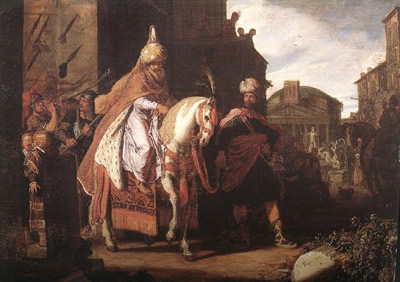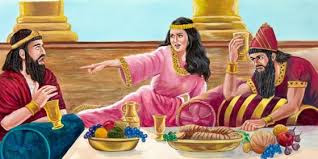Note—It is a special two-fer
Thursday. This year the Jewish festival
of Purim and Saint Patrick’s Day coincide to say nothing of my 73rd orbital
anniversary. Usually such convergences
would inspire poetry, but nothing new oozed out this time. Instead we will feature versions of two
chestnuts for the occasion.
Jewish
holiday Purim is observed today. It is one of my favorites of all religious celebrations. As a Rabbi
who spoke at the Peace
and Unity Prayer Vigil at Islamic
Foundation North in Waukegan a few years ago said. “Purim is a holy day when
we are commanded to have fun.”
To familiarize folks with her
story and the joyous festival which commemorates how a Jewish concubine in
a royal court saved her people—I’m talking to my fellow Goyim—we review just what the
hell went on.
A young girl, Esther, was picked by a drunken Persian king to be his new bride.
She kept her Jewish identity
a secret. Meanwhile her protector and cousin
Mordecai discovered a plot
to kill the king and by informing saved his life.
A Purim greeting card.
The King appointed the vain and treacherous Haman as his new Vizier. Haman was offended
when Mordecai was insufficiently
obsequious to him in public. Miffed,
he plotted to have not just Mordecai, but all the Jews of kingdom killed. He got the king, who had been participating
in public drinking festivals for six
months and was perhaps a tad addled,
to sign such a decree.
After sending words to the Jews of the kingdom to join in
three days fast and prayer Esther got the king drunk yet
again at a royal drinking festival that she hosted with Haman among the guests.
After the first night of debauchery Esther read to the King the annals
of Mordecai’s life saving service.
She then asked Haman what boon the King should give to a man who has done him great
service. Vainly thinking she means
him, Haman said the honoree should
be dressed in the royal robes
and paraded before the people on the
king’s own horse.
The king astounded Haman by bestowing the boon on
Mordecai and ordered him to see that the command was carried out.
On the second night of the Festival Esther revealed that
she is Jewish as was her cousin and that by the edict the king himself had
signed all of her people, and she herself were marked for death. Outraged,
the king ordered Haman hung on the
gallows built for Mordecai and named the Jew as his new Vizier.
Esther denounce Haman to the drunken King.
But he could not revoke
his own edict. Instead he issued another
which allowed Jews to arm themselves and
slay their attackers. On the 13th
Day of Adar, the planned attacks were launched but the Jews slaid their
attackers by the hundreds and thousands, including all seven sons of Haman.
The Jewish people were saved and flourished for a while as never before in exile.
Purim celebrates the deliverance exuberantly with costumed recreations of the story, noise makers meant to drown out
Haman’s name whenever it is read in the telling of the story, special foods, and of course plenty
of drinking and merrymaking.
Ten years ago, in 2012 the celebration coincided with International Women’s Day on March
8. This year the slippery Jewish lunar calendar
missed that by more than a week.
Back then I was intrigued because at the center of
Purim is one of the few women of the
Hebrew Bible or Old Testament to take a leading
role in the story. The lovely Queen
Esther always struck me as wonderfully subversive
and feminist. The story of Esther, heroine and
savior of her People, resonates with women whether Jewish or Gentile.
So, I wrote her a poem imagining her sitting down with
some contemporary sisters.
Purim/International Women’s Day
14th day of Adar 5772/March 8, 2012
Queen Esther tossed her head,
gleaming
black hair
tumbling
to those lovely shoulders
that
had enticed a lecher King.
She
laughed.
Her people, the Women of another age,
leaned
toward her
waiting
her word.
She cast her blazing eyes upon them,
laughed
again
and
spoke at last.
“So many Hamans.
Where shall we begin?”
—Patrick Murfin






No comments:
Post a Comment